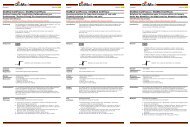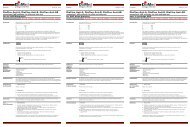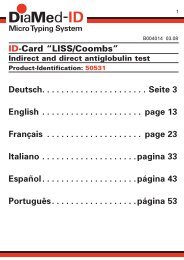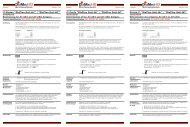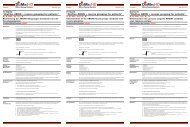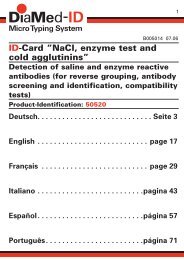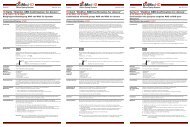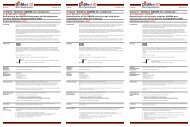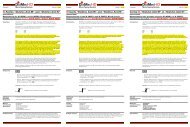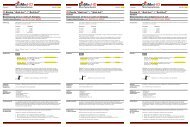Anti-A1 absorbed
Anti-A1 absorbed
Anti-A1 absorbed
Create successful ePaper yourself
Turn your PDF publications into a flip-book with our unique Google optimized e-Paper software.
Français B001811 07.07 English B001811 07.07 Deutsch B001811 07.07Interprétationdes résultatsA) Principe [3]Positif: Hématies agglutinées formant une ligne rouge à la surface du gel ou desagglutinats dispersés dans le gel.Négatif: Hématies en culot compact au fond du microtube.Interpretationof resultsA) Principle [3]Positive: Agglutinated cells forming a red line on the surface of the gel oragglutinates dispersed in the gel.Negative: Compact button of cells on the bottom of the microtube.Interpretationder ErgebnisseA) Prinzip [3]Positiv: Agglutinierte Erythrozyten bilden eine rote Linie auf dem Gel oder sind imGel verteilt.Negativ: Kompaktes Erythrozytensediment am Boden des Mikroröhrchens.B) Réactions pour les antigènes des sous-groupes de AB) Reactions for A subgroups antigensB) Reaktionen für A-Untergruppen <strong>Anti</strong>gene<strong>Anti</strong>-A <strong>Anti</strong>-AB <strong>Anti</strong>-A 1 <strong>Anti</strong>-H<strong>Anti</strong>-A <strong>Anti</strong>-AB <strong>Anti</strong>-A 1 <strong>Anti</strong>-H<strong>Anti</strong>-A <strong>Anti</strong>-AB <strong>Anti</strong>-A 1 <strong>Anti</strong>-HA 1 ++++ ++++ ++ à ++++ nég. à +A 1 ++++ ++++ ++ to ++++ neg. to +A 1 ++++ ++++ ++ bis ++++ neg. bis +A int ++++ ++++ ++ à +++ ++ à +++A int ++++ ++++ ++ to +++ ++ to +++A int ++++ ++++ ++ bis +++ ++ bis +++A 2 +++ à ++++ ++++ nég. à + ++ à ++++A 2 +++ to ++++ ++++ neg. to + ++ to ++++A 2 +++ bis ++++ ++++ neg. bis + ++ bis ++++A 3 + à +++* ++ à ++++ nég. ++ à ++++A 3 + to +++* ++ to ++++ neg. ++ to ++++A 3 + bis +++* ++ bis ++++ neg. ++ bis ++++A x nég. à + + à +++ nég. ++ à ++++A x neg. to + + to +++ neg. ++ to ++++A x neg. bis + + bis +++ neg. ++ bis ++++A 1 B ++++ ++++ ++ à ++++ nég. à +A 1 B ++++ ++++ ++ to ++++ neg. to +A 1 B ++++ ++++ ++ bis ++++ neg. bis +A 2 B +++ à ++++ ++++ nég. à + + à ++A 2 B +++ to ++++ ++++ neg. to + + to ++A 2 B +++ bis ++++ ++++ neg. bis + + bis ++A 3 B ++ à ++++* ++++ nég. nég. à ++A 3 B ++ to ++++* ++++ neg. neg. to ++A 3 B ++ bis ++++* ++++ neg. neg. bis ++A x B nég. à + ++++ nég. + à +++A x B neg. to + ++++ neg. + to +++A x B neg. bis + ++++ neg. + bis +++* Une double population peut être parfois observée et doit être considérée commeréaction positive.* Double populations may occasionally be observed, and should be interpreted aspositive.* Gelegentlich können Doppelpopulationen beobachtet werden. Diese sind als positiv zuinterpretieren.RemarquesAvant de procéder à une recherche d‘antigène, s‘assurer que les hématies à tester sontdépourvues d‘autoanticorps réagissant en technique enzymatique.RemarksPrior to testing for the presence of antigens, it must be assured that the red cells are freeof enzyme reactive autoantibodies.AnmerkungenVor dem Testen der <strong>Anti</strong>gene ist sicherzustellen, dass die Erythrozyten keine mit Enzymenreagierenden Autoantikörper enthalten.Limitesa) Les cartes-ID présentant des bulles d‘air dans le gel ou des goutelettes dans la partiesupérieur des microtubes ou sur la languette métallique doivent être centrifugéesavant utilisation.b) Des contaminations, bactériennes ou autres, du matériel utilisé peuvent provoquerdes résultats faussement positifs ou faussement négatifs.c) Des résidus de fibrine dans la suspension d’hématies peuvent emprisonner quelquescellules non agglutinées, formant ainsi une fine ligne rose à la surface du gel, alorsque la plupart des hématies sont dans le fond du microtube aprés centrifugation.d) L’observation stricte des méthodes et l’emploi de l’équipement recommandé sontessentiels. L’équipement doit être régulièrement contrôlé selon les procédures desGLP.e) L’utilisation de diluants autres que l’ID-Diluent 1 peut modifier les résultats.f) Des suspensions d’hématies trop concentrées ou trop diluées peuvent provoquer desrésultats aberrants.Limitationsa) ID-Cards which show air bubbles in the gel or drops in the upper part of themicrotubes and/or the seal, must be centrifuged before use.b) Bacterial or other contamination of materials used can cause false positive or falsenegative results.c) Fibrin residues in the red cell suspension may trap non-agglutinated cells presenting afine pink line on top of the gel while most of the cells are on the bottom of themicrotube after centrifugation.d) Strict adherence to the procedures and recommended equipment is essential. Theequipment should be checked regularly according to GLP procedures.e) Use of suspension solutions other than ID-Diluent 1 may modify the reactions.f) Too heavy or too weak red cell suspensions can cause aberrant results.Einschränkungena) ID-Karten mit Luftblasen im Gel oder Tropfen im oberen Bereich der Mikrokammernund/oder Versiegelung müssen vor Gebrauch zentrifugiert werden.b) Bakterielle oder andere Kontaminationen des verwendeten Materials können falschpositive oder falsch negative Ergebnisse verursachen.c) Fibrinreste in der Erythrozytensuspension können nicht-agglutinierte Erythrozytenverkleben, die sich als feine rosa Linie auf der Geloberfläche darstellen, während diemeisten Erythrozyten nach Zentrifugation am Boden der Mikroröhrchen ein kompaktesSediment bilden.d) Striktes Befolgen der Anleitungen und Verwendung des erforderlichen Arbeitmaterialssind unerlässlich. Das Arbeitsmaterial sollte regelmässig entsprechend derGLP-Richtlinien überprüft werden.e) Der Gebrauch anderer Lösungen als ID-Diluent 1 für die Erythrozytensuspensionenkann die Reaktionen beeinflussen.f) Zu starke oder zu schwache Erythrozytensuspensionen können abnormale Reaktionenhervorrufen.Bibliographie1. Mollison P. L., Engelfried C. P., and Contreras, M.: Blood Transfusion in ClinicalMedicine. 10 th ed. 1997; Blackwell Scientific Publications, Oxford.2. Technical Manual; 11 th ed. 1993; American Association of Blood Banks.3. Lapierre, Y., Rigal, D., Adam, J. et al.: The gel test; A new way to detect red cellantigen-antibody reactions. Transfusion 1990; 30: 109 –113.Bibliography1. Mollison P. L., Engelfried C. P., and Contreras, M.: Blood Transfusion in ClinicalMedicine. 10 th ed. 1997; Blackwell Scientific Publications, Oxford.2. Technical Manual; 11 th ed. 1993; American Association of Blood Banks.3. Lapierre, Y., Rigal, D., Adam, J. et al.: The gel test; A new way to detect red cellantigen-antibody reactions. Transfusion 1990; 30: 109 –113.Literatur1. Mollison P. L., Engelfried C. P., and Contreras, M.: Blood Transfusion in ClinicalMedicine. 10 th ed. 1997; Blackwell Scientific Publications, Oxford.2. Technical Manual; 11 th ed. 1993; American Association of Blood Banks.3. Lapierre, Y., Rigal, D., Adam, J. et al.: The gel test; A new way to detect red cellantigen-antibody reactions. Transfusion 1990; 30: 109 –113.Produits Carte-ID “<strong>Anti</strong>-A 1 <strong>absorbed</strong> 1 x 12 . . . . .REF 001811 Products ID-Card “<strong>Anti</strong>-A 1 <strong>absorbed</strong> 1 x 12 . . . . .REF 001811 Produkte ID-Karte “<strong>Anti</strong>-A 1 <strong>absorbed</strong> 1 x 12 . . . . .REF 001811Ces produits sont garantis quant à leurs propriétés et qualités stipulées sur l’étiquetteet dans le mode opératoire. Le fabricant décline toute responsabilité pour les cas où cesproduits seraient employés ou vendus à d’autres usages.These products are guaranteed to perform as described on the label and in theinstruction sheet. The manufacturer declines all responsibility arising out of the use orsale of these products in any way or for any purpose other than those described therein.Für diese Produkte wird nur Garantie übernommen, wenn sie gemäss den Angaben aufdem Etikett und der Anwendungsvorschrift verwendet werden. Jegliche Verantwortungwird ausdrücklich abgelehnt, wenn das Präparat für andere Zwecke gebraucht oderverkauft wird.DiaMed SA, 1785 Cressier s/Morat, Suisse DiaMed AG, 1785 Cressier s/Morat, Switzerland DiaMed AG, 1785 Cressier s/Morat, Schweiz
Português B001811 07.07 Español B001811 07.07 Italiano B001811 07.07Interpretaçãodos resultadosA) Princípio [3]Positivo: Eritrócitos aglutinados formando uma linha vermelha à superfície do gel ouaglutinados dispersos no gel.Negativo: Botão compacto de eritrócitos no fundo do microtubo.Interpretaciónde losresultadosA) Principio [3]Positivo: Los eritrocitos aglutinados forman una línea roja sobre la superficie del gel oaparecen dispersos en el gel.Negativo: Sedimento compacto de hematíes en el fondo del microtubo.Interpretazionedei risultatiA) Principio [3]Positivo: Gli eritrociti agglutinati formano una linea rossa sul gel o sono distribuiti nelgel.Negativo: Bottone compatto di eritrociti sul fondo della provetta.B) Reacções para os antigénios dos subgrupos de AB) Reacciones para los antigenos de los subgrupos AB) Reazioni per gli antigeni dei sottogruppi di A<strong>Anti</strong>-A <strong>Anti</strong>-AB <strong>Anti</strong>-A 1 <strong>Anti</strong>-H<strong>Anti</strong>-A <strong>Anti</strong>-AB <strong>Anti</strong>-A 1 <strong>Anti</strong>-H<strong>Anti</strong>-A <strong>Anti</strong>-AB <strong>Anti</strong>-A 1 <strong>Anti</strong>-HA 1 ++++ ++++ ++ a ++++ neg. a +A 1 ++++ ++++ ++ a ++++ neg. a +A 1 ++++ ++++ ++ a ++++ neg. a +A int ++++ ++++ ++ a +++ ++ a +++A int ++++ ++++ ++ a +++ ++ a +++A int ++++ ++++ ++ a +++ ++ a +++A 2 +++ a ++++ ++++ neg. a + ++ a ++++A 2 +++ a ++++ ++++ neg. a + ++ a ++++A 2 +++ a ++++ ++++ neg. a + ++ a ++++A 3 + a +++* ++ a ++++ neg. ++ a ++++A 3 + a +++* ++ a ++++ neg. ++ a ++++A 3 + a +++* ++ a ++++ neg. ++ a ++++A x neg. a + + a +++ neg. ++ a ++++A x neg. a + + a +++ neg. ++ a ++++A x neg. a + + a +++ neg. ++ a ++++A 1 B ++++ ++++ ++ a ++++ neg. a +A 1 B ++++ ++++ ++ a ++++ neg. a +A 1 B ++++ ++++ ++ a ++++ neg. a +A 2 B +++ a ++++ ++++ neg. a + + a ++A 2 B +++ a ++++ ++++ neg. a + + a ++A 2 B +++ a ++++ ++++ neg. a + + a ++A 3 B ++ a ++++* ++++ neg. neg. a ++A 3 B ++ a ++++* ++++ neg. neg. a ++A 3 B ++ a ++++* ++++ neg. neg. a ++A x B neg. a + ++++ neg. + a +++A x B neg. a + ++++ neg. + a +++A x B neg. a + ++++ neg. + a +++* Ocasionalmente é possível observar-se uma dupla população, devendo serinterpretada como positiva.* Ocasionalmente pueden observarse dobles poblaciones, que deben interpretarsecomo positivas.* Occasionalmente si può osservare una doppia popolazione, che deve essereinterpretata come risultato positivo.ObservaçõesAntes de investigar a presença de antigénios, é necessário certificar-se de que oseritrócitos estão isentos de anticorpos que reajam a técnicas enzimáticas.ObservacionesAntes de determinar la presencia de antígenos, hay que asegurarse que los eritrocitos nopresentan autoanticuerpos reactivos a enzimas.NotePrima di procedere con la ricerca degli antigeni, accertasi che gli eritrociti siano privi diautoanticorpi reattivi in enzimi.Limitaçõesa) Os cards-ID que tenham bolhas de ar no gel ou gotas na parte superior dosmicrotubos e/ou no segmento de alumínio devem ser centrifugados antes de usar.b) A contaminação, bacteriana ou outra dos materiais utilizados pode causar resultadosfalsamante positivos ou falsamente negativos.c) Resíduos de fibrinas na suspensão de eritrócitos podem reter eritrócitos nãoaglutinados, formando assim uma fina linha cor-de-rosa à superfície do gel, ao passoque a maior parte dos eritrócitos migra para o fundo do microtubo apóscentrifugação.d) O cumprimento estrito dos procedimentos e a utilização do equipamentorecomendado são essenciais. O equipamento deve ser verificado regularmente emconformidade com os procedimentos de BPL.e) A utilização de soluções de suspensão diferentes de ID-Diluent 1 pode alterar asreacções.f) Suspensões de eritrócitos demasiado concentradas ou demasiado diluidas podemprovocar resultados errados.Limitacionesa) Las ID-Tarjetas que muestren burbujas de aire en el gel o gotas en la parte superior delos microtubos y/o de la lámina de sellado, deben ser centrifugadas antes de usarlas.b) La contaminación de los materiales empleados, bacteriana o de otro tipo, puedeprovocar falsos positivos o falsos negativos.c) Los restos de fibrina en la suspensión de eritrocitos pueden atrapar los hematíes noaglutinados, de modo que aparezca una fina línea rosada en la parte superior del gelmientras que la mayoría de los eritrocitos se encuentran en el fondo del microtubotras el centrifugado.d) Es esencial atenerse estrictamente a los procedimientos y equipos recomendados. Elequipo debe comprobarse periódicamente según la normativa de prácticas delaboratorio correctas (GLP).e) El empleo de soluciones de suspensión distintas al ID-Diluent 1 puede modificar lasreacciones.f) Las suspensiones de eritrocitos demasiado concentradas o demasiado diluidaspueden dar lugar a resultados aberrantes.Limitazionia) Le ID-Cards che mostrano bolle d’aria nel gel o gocce nella parte superiore delmicropozzetto e/o sul foglio di alluminio, devono essere centrifugate prima dell’uso.b) Contaminazioni batteriche o di altro tipo del materiale utilizzato possono essere causadi risultati falsamente negativi o positivi.c) Eventuali residui di fibrina nella sospensione di eritrociti possono aderire alle emazienon agglutinate e farle apparire come una una sottile linea rosa sulla superficie delgel, mentre la maggior parte degli eritrociti dopo la centrifugazione forma un bottonecompatto sul fondo della provetta.d) È indispensabile seguire scrupolosamente le istruzioni e impiegare il materiale dilavoro raccomandato. Il materiale di lavoro deve essere controllato regolarmentesecondo le direttive GLP.e) L‘uso di soluzioni per sospensione diverse da ID-Diluent 1 può alterare le reazioni.f) Una sospensione di eritrociti troppo concentrata o troppo diluita può causare reazionianomale.Bibliografia1. Mollison P. L., Engelfried C. P., and Contreras, M.: Blood Transfusion in ClinicalMedicine. 10 th ed. 1997; Blackwell Scientific Publications, Oxford.2. Technical Manual; 11 th ed. 1993; American Association of Blood Banks.3. Lapierre, Y., Rigal, D., Adam, J. et al.: The gel test; A new way to detect red cellantigen-antibody reactions. Transfusion 1990; 30: 109 –113.Bibliografía1. Mollison P. L., Engelfried C. P., and Contreras, M.: Blood Transfusion in ClinicalMedicine. 10 th ed. 1997; Blackwell Scientific Publications, Oxford.2. Technical Manual; 11 th ed. 1993; American Association of Blood Banks.3. Lapierre, Y., Rigal, D., Adam, J. et al.: The gel test; A new way to detect red cellantigen-antibody reactions. Transfusion 1990; 30: 109 –113.Bibliografia1. Mollison P. L., Engelfried C. P., and Contreras, M.: Blood Transfusion in ClinicalMedicine. 10 th ed. 1997; Blackwell Scientific Publications, Oxford.2. Technical Manual; 11 th ed. 1993; American Association of Blood Banks.3. Lapierre, Y., Rigal, D., Adam, J. et al.: The gel test; A new way to detect red cellantigen-antibody reactions. Transfusion 1990; 30: 109 –113.Produtos Card-ID “<strong>Anti</strong>-A 1 <strong>absorbed</strong> 1 x 12 . . . . .REF 001811 Productos Tarjeta ID-Card “<strong>Anti</strong>-A 1 <strong>absorbed</strong> 1 x 12 . . . . .REF 001811 Prodotti Scheda ID “<strong>Anti</strong>-A 1 <strong>absorbed</strong> 1 x 12 . . . . .REF 001811Estes produtos são garantidos quanto ao seu comportamento funcional, tal comodescrito no rótulo e no folheto informativo. O fabricante declina toda a responsabilidadedecorrente da utilização ou venda destes produtos para fins diferentes dos aí descritos.Se garantiza que estos productos se comportarán según lo descrito en la etiqueta y en lahoja de instrucciones. El fabricante declina toda responsabilidad en caso de que losproductos se utilicen o vendan para cualquier otro uso diferente de los allí descritos.Si garantiscono per questi prodotti le prestazioni descritte sull‘etichetta e nel foglio diistruzioni. Il produttore declina ogni responsabilità derivante dall‘uso improprio o dallavendita di questi prodotti per scopi diversi da quelli qui descritti.DiaMed AG, 1785 Cressier s/Morat, Suíça DiaMed AG, 1785 Cressier s/Morat, Suiza DiaMed AG, 1785 Cressier s/Morat, Svizzera




